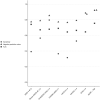Prediction of underlying atrial fibrillation in patients with a cryptogenic stroke: results from the NOR-FIB Study
- PMID: 37162578
- PMCID: PMC10344988
- DOI: 10.1007/s00415-023-11680-8
Prediction of underlying atrial fibrillation in patients with a cryptogenic stroke: results from the NOR-FIB Study
Abstract
Background: Atrial fibrillation (AF) detection and treatment are key elements to reduce recurrence risk in cryptogenic stroke (CS) with underlying arrhythmia. The purpose of the present study was to assess the predictors of AF in CS and the utility of existing AF-predicting scores in The Nordic Atrial Fibrillation and Stroke (NOR-FIB) Study.
Method: The NOR-FIB study was an international prospective observational multicenter study designed to detect and quantify AF in CS and cryptogenic transient ischaemic attack (TIA) patients monitored by the insertable cardiac monitor (ICM), and to identify AF-predicting biomarkers. The utility of the following AF-predicting scores was tested: AS5F, Brown ESUS-AF, CHA2DS2-VASc, CHASE-LESS, HATCH, HAVOC, STAF and SURF.
Results: In univariate analyses increasing age, hypertension, left ventricle hypertrophy, dyslipidaemia, antiarrhythmic drugs usage, valvular heart disease, and neuroimaging findings of stroke due to intracranial vessel occlusions and previous ischemic lesions were associated with a higher likelihood of detected AF. In multivariate analysis, age was the only independent predictor of AF. All the AF-predicting scores showed significantly higher score levels for AF than non-AF patients. The STAF and the SURF scores provided the highest sensitivity and negative predictive values, while the AS5F and SURF reached an area under the receiver operating curve (AUC) > 0.7.
Conclusion: Clinical risk scores may guide a personalized evaluation approach in CS patients. Increasing awareness of the usage of available AF-predicting scores may optimize the arrhythmia detection pathway in stroke units.
Keywords: Atrial fibrillation; Biomarkers; Cryptogenic stroke; ICM; Prediction scores; Predictors.
© 2023. The Author(s).
Conflict of interest statement
AHA has received travel support, and honoraria for advice or lecturing from Bayer, Boehringer Ingelheim, BMS, Abbvie, Teva, Novartis, Roche, Pfizer, and Teva, research grant from Boehringer Ingelheim. DA has received honoraria and consultation fees from Actelion, Amgen, AstraZeneca, BMS/Pfizer, Bayer, Boehringer-Ingelheim, MSD, Novartis, Pharmacosmos, Roche Diagnostics, Sanofi, Takeda, and Vifor Pharma, and research funding (to the institution) from BMS/Pfizer, Bayer, Roche Diagnostics and Medtronic. BRT and ATL have received travel funding from Medtronic.
Figures


References
-
- Tsivgoulis G, Triantafyllou S, Palaiodimou L, Grory BM, Deftereos S, Köhrmann M, Dilaveris P, Ricci B, Tsioufis K, Cutting S, Magiorkinis G, Krogias C, Schellinger PD, Dardiotis E, Rodriguez-Campello A, Cuadrado-Godia E, Aguiar de Sousa D, Sharma M, Gladstone DJ, Sanna T, Wachter R, Furie KL, Alexandrov AV, Yaghi S, Katsanos AH. Prolonged cardiac monitoring and stroke recurrence: a meta-analysis. Neurology. 2022;98(19):e1942–e1952. doi: 10.1212/WNL.0000000000200227. - DOI - PubMed
-
- Cuadrado-Godia E, Benito B, Ois A, Vallès E, Rodríguez-Campello A, Giralt-Steinhauer E, Cabrera S, Alcalde O, Jiménez-López J, Jiménez-Conde J, Martí-Almor J, Roquer J. Ultra-early continuous cardiac monitoring improves atrial fibrillation detection and prognosis of patients with cryptogenic stroke. Eur J Neurol. 2020;27(2):244–250. doi: 10.1111/ene.14061. - DOI - PubMed
Publication types
MeSH terms
LinkOut - more resources
Full Text Sources
Medical

